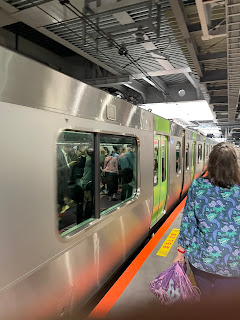After our group orientation meeting, we boarded a motor coach for a trip into central Tokyo. Along the way, we passed the emperor's palace, the Diet (parliament), and the Supreme Court buildings. But the palace is completely hidden by trees and the other buildings weren't interesting enough to try to get photos from the bus.
We did stop at the national sumo wrestling arena. This is a big place that seats thousands. Fortunately, it gets used for other sorts of events, because there are only three sumo tournaments each year (though each tournaments lasts two weeks).
We could only visit the exterior of the arena, but in a building next door that is full of sumo-themed shops and restaurants we were able to get up close to a replica sumo ring. It's much smaller than we'd pictured, only about 15 feet in diameter. It is made of straw bales and packed clay, and a new ring is constructed for each tournament. The construction is done with manual labor and hand tools and takes about two weeks.
We moved on to a tourist venue operated by a pair of retired sumo wrestlers. Since most sumo wrestlers retire in the early to mid-thirties, these guys were not old. Since retirement, they had trimmed down from their fighting weights -- one was 6'1" and 280 pounds, the other was 5'10" and 320 pounds! They put on a bit of a show for us, explaining the training, a simplified explanation of the rules, some of the basic moves. They were also clearly having fun.
After the demo, they served us a trimmed down version of a typical training meal in a sumo stable. It was very trimmed down, because it was a rather skimpy lunch. We are in no danger of gaining wight on a bowl of vegetable soup and a paddy of sticky rice. But beginning wrestlers do the cooking for the stable and serve their more senior stablemates, so that part was sort of authentic.
We finished with a photo op and returned to the bus for a trip to the main Shinto shrine of Tokyo. The Meiji Shrine is dedicated to the deified spirits of Emperor Meiji and his wife, Empress Shōken. Meiji, who ruled from 1867 to 1912, is revered for transforming Japan from a feudal society into a modern industrial nation.
Like the palace, the shrine is surrounded by a forest. Shinto is basically an animistic religion that worships nature, so the natural surroundings are important. After passing the entrance gate, visitors are asked to stop by a fountain to wash their hands and faces as an act of purification before entering further.
 |
| Sake barrels from an annual ceremony at the shrine |
While we were there, a traditional Japanese wedding procession came through. The bride and groom looked to be barely in their late teens -- much younger than the average age of marriage in modern Japan.
The motor coach dropped us at a subway station near the shrine where we had our first experience with Tokyo's vast metro system. We rode one stop to the famous Shibuya Scramble Square, where once every few minutes traffic is stopped in all directions and hundreds of pedestrians cross every which way, in all directions, dodging one another, to cross before the light changes once again.
New this square was a loud and raucous protest in support of Palestine -- primarily led by non-Japanese, Arab-looking men. We hung around, not to listen to the protestors, but to watch the huge video displays that show an amazing 3-D display at the top of the hour.
From Shibuya Square we walked to another subway station and rode the metro back to our hotel for a short break. Before our rest, we had a small adventure at 7-11, learning how to use the machine to put more Yen on our transit cards. Once again this afternoon, Peter and Betsey hosted a happy hour in the breakfast room.
Then, at about 6:30 p.m., our tour leader Mariko took half the group, the willing, on another short subway ride to the other side of Shijuku where a new Godzilla video was to be projected onto the side of a large government building. There must have been a couple thousand people gathered there! We infiltrated the crowd and got a kick out of seeing Godzilla destroy the building, then seeing it reconstructed in moments.
The crowd dispersed and Mariko guided us to a nearby restaurant for a nice meal of Japanese foods and beer.
At Mariko's suggestion, we skipped the metro and walked back to the hotel. She guided us down back alleys and through a red light district before delivering us back. It was a beautiful spring evening and there were people everywhere! It was a fascinating walk, capping more than seven miles of walking today.












No comments:
Post a Comment